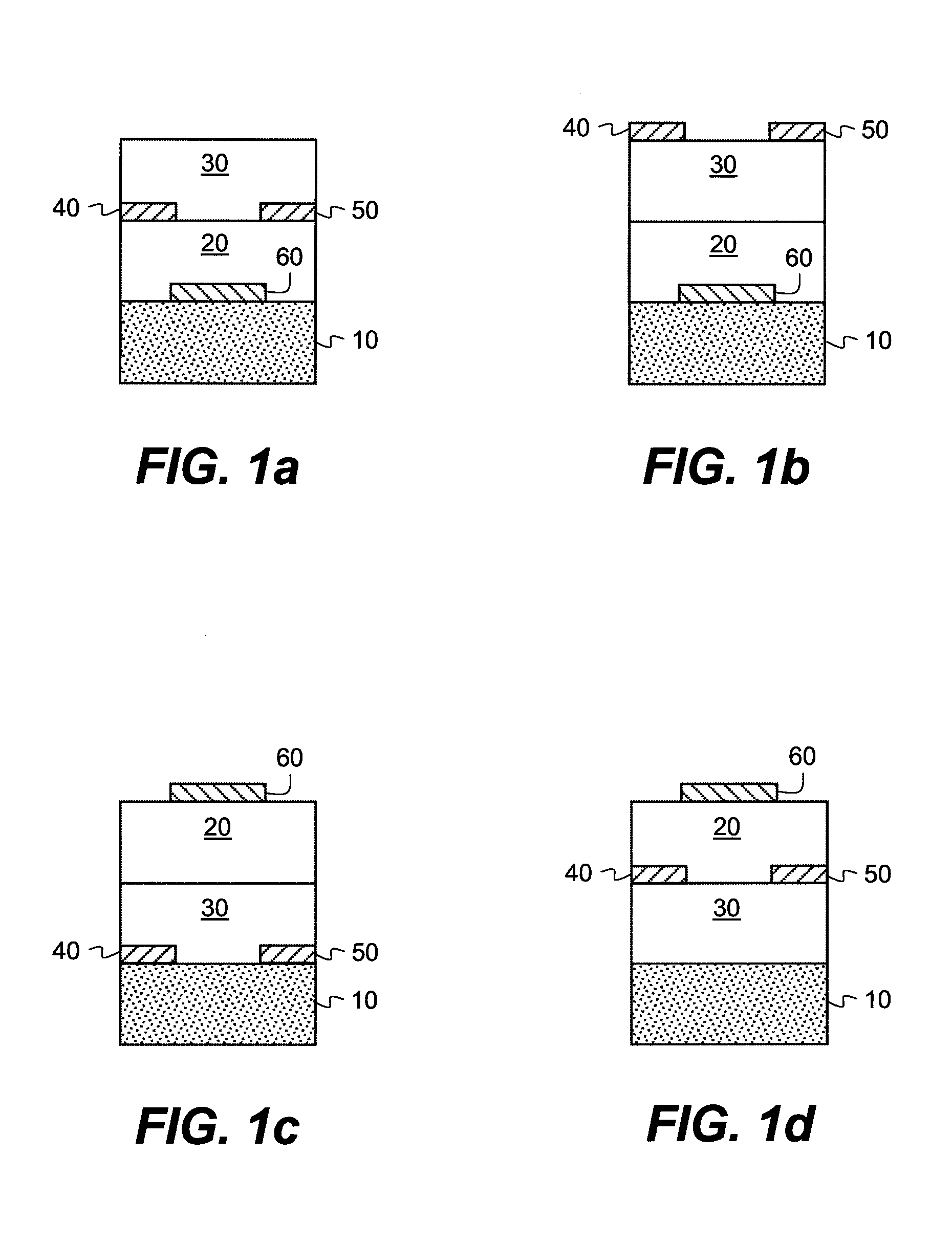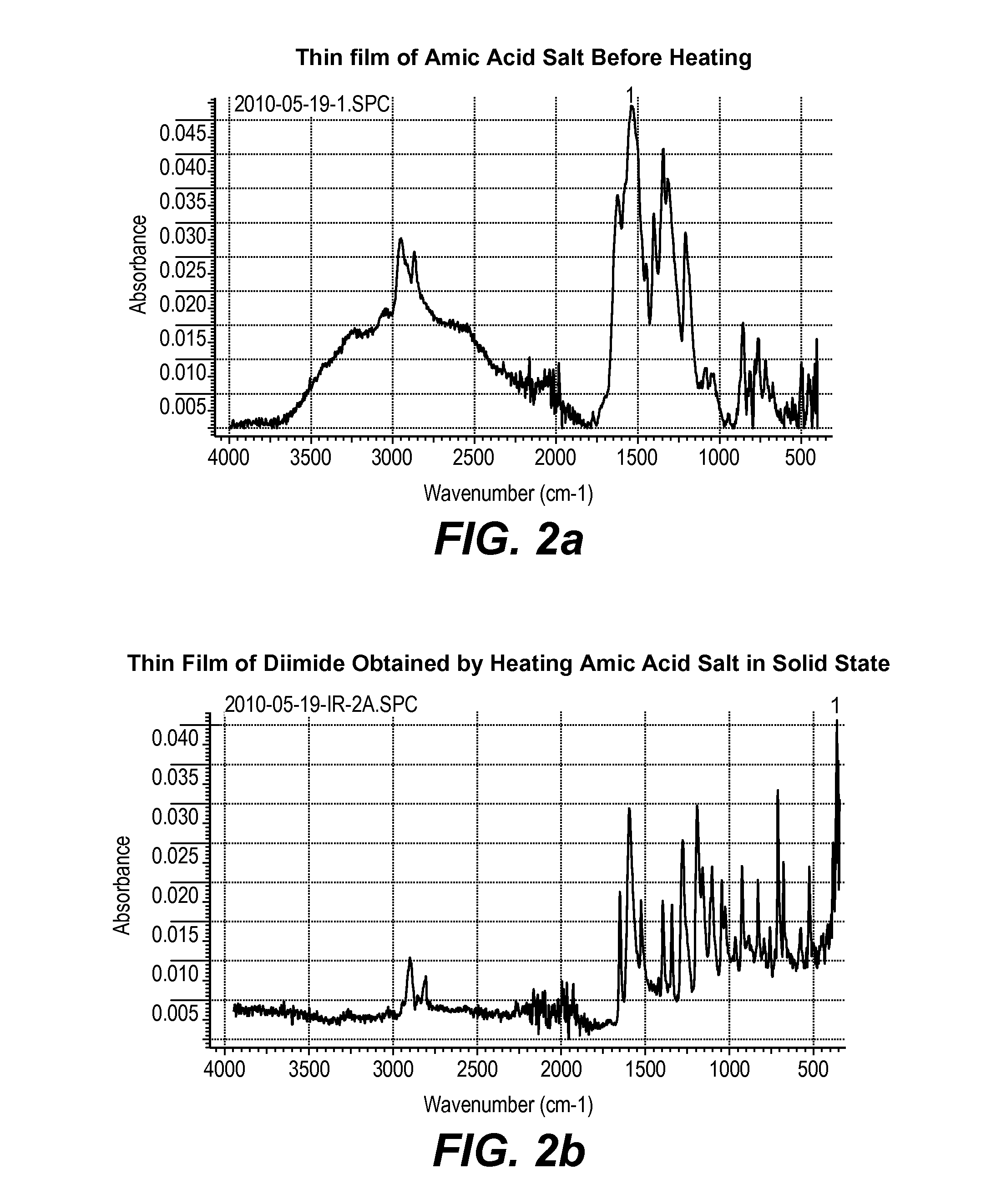Methods of providing semiconductor layers from amic acid salts
a technology of amic acid salts and semiconductor layers, which is applied in the field of providing semiconductor layers, can solve the problems of low on/off ratio of materials, difficult preparation and purification, and failure to suggest comparative advantages of using cycloalkyl groups on imide nitrogen atoms, etc., and achieves easy preparation, low temperature conversion, and readily available materials
- Summary
- Abstract
- Description
- Claims
- Application Information
AI Technical Summary
Benefits of technology
Problems solved by technology
Method used
Image
Examples
invention example 1
Preparation of di-(cyclopentylammonium)-4,8-bis-(cyclopentylcarbamoyl)-naphthalene-1,5-dicarboxylate as a mixture of trans- and cis-isomers (Compounds I-26 and I-29)
[0256]
[0257]To a stirred dispersion of 1,4,5,8-naphthalene tetracarboxylic acid dianhydride (46 mg) in tetrahydrofuran (4 ml), a solution of cyclopentylamine (mg) in tetrahydrofuran (1 ml) was added dropwise to obtain first a clear pale yellow solution that quickly turned cloudy. Stirring was continued for an additional 5 minutes then excess diethyl ether was added to obtain a precipitate that was filtered, washed with diethyl ether, and dried in air.
[0258]1H and 13C NMR spectra of the product were consistent with the salt being a mixture of cis and trans isomers. The aromatic protons of the trans-isomer appeared as a two doublets at 7.79 ppm (J=7.60 Hz) and 7.63 ppm (J ˜7 Hz); aromatic protons of the cis isomer appeared as singlets at 7.81 ppm and 7.62 ppm. From the integrated areas of the aromatic protons, it was deter...
invention example 2
Conversion of di-(cyclopentylammonium)-4,8-bis(cyclopentylcarbamoyl)-naphthalene-1,5-dicarboxylate as a mixture of trans and cis isomers (Compounds I-26 and I-29) to N,N′-biscyclopentyl Naphthalene Diimide in Solid State
[0259]
[0260]A solution of di-(cyclopentylammonium)-4,8-bis(cyclopentylcarbamoyl)-naphthalene-1,5-dicarboxylate salt in methanol (2 weight %) was spin coated on a glass plate and solvent evaporated at 40-50° C. The thin solid film of the salt was then heated at 180° C. for 10 minutes and resulting product dissolved in CDCl3 and 1H NMR spectrum recorded and compared with an authentic sample of N,N′-bis(cyclopentyl)naphthalene diimide. The 1H NMR spectrum of the product obtained by solid state thermal conversion of amic acid salt was identical to that of the authentic sample. This clearly demonstrated that the amic acid salt can be easily converted to the corresponding diimide in thin solid film. 1H NMR (CDCl3, 300 MHz) δ(ppm)=8.72 (s, 4H), 5.55 (q, 2H, J=8.2 Hz), 2.35-...
invention example 3
Preparation of di-(cyclohexylammonium)-4,8-bis(cyclohexylcarbamoyl)-naphthalene-1,5-dicarboxylate as a mixture of trans and cis isomers
[0268]
[0269]To a stirred dispersion of 1,4,5,8-naphthalene tetracarboxylic acid dianhydride (46 mg, 0.17 mmol) in tetrahydrofuran (4 ml), a solution of cyclohexylamine (68 mg, 0.68 mmol) in tetrahydrofuran (1 ml) was added dropwise to obtain first a clear pale yellow solution that quickly turned cloudy. Stirring was continued for an additional 5 minutes, then excess diethyl ether was added to obtain a precipitate that was filtered, washed with diethyl ether, and dried in air.
[0270]1H and 13C NMR spectra of the product were consistent with the salt being a mixture of cis and trans isomers. The aromatic protons of the trans-isomer appeared as a two doublets at 7.78 ppm (J=7.60 Hz) and 7.63 ppm (J ˜7 Hz); aromatic protons of the cis isomer appeared as singlets at 7.81 ppm and 7.61 ppm. From the integrated areas of the aromatic protons, it was determined...
PUM
 Login to View More
Login to View More Abstract
Description
Claims
Application Information
 Login to View More
Login to View More - R&D Engineer
- R&D Manager
- IP Professional
- Industry Leading Data Capabilities
- Powerful AI technology
- Patent DNA Extraction
Browse by: Latest US Patents, China's latest patents, Technical Efficacy Thesaurus, Application Domain, Technology Topic, Popular Technical Reports.
© 2024 PatSnap. All rights reserved.Legal|Privacy policy|Modern Slavery Act Transparency Statement|Sitemap|About US| Contact US: help@patsnap.com










